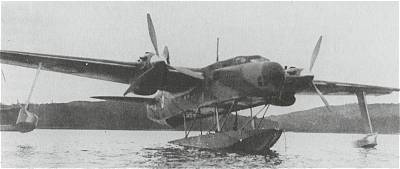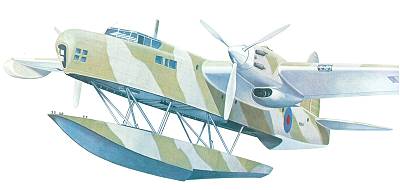Blackburn
B.20

Blackburn B.20
BlackburnB.20 |
 Blackburn B.20 |
The Blackburn B.20 was an attempt at fixing some of the problems associated with flying boat design. With medium-sized aircraft, keeping the propellors clear of water and spray posed a challenge. The optimal wing angles of incidence for take-off and cruising flight usually did not coincide either. Blackburn's head of seaplane design, Major J. D. Rennie, patented (Patent # 433925) a possible solution to these challenges. The B.20 maritime reconnaissance prototype embodied these ideas. The lower portion of the hull could be lowered, effectively making the B.20 a floatplane. The extended lower hull kept the engines and props clear of water, and it was also set at such an angle that the wing's incidence was optimal for take-off. Once airborne, the hull could be retracted flush with the fuselage to present the streamlined shape of a conventional flying boat. The design also featured floats which retracted outward to form the wingtips.

Performance of the B.20 was satisfactory, and work was begun on a developed prototype. No armament was installed in the B.20, although provision was made for it. A crew of seven could be carried, and there was enough room for sleeping quarters, a wardroom, workroom, galley and head for extended missions. Unfortunately, Rennie's concept never entered service use. The B.20 prototype was lost during a test flight, possibly due to an engine malfunction or aileron flutter. Due to wartime demands, no further development was undertaken, and the end of World War II saw the dawn of jetliners and the decline of the flying boat.

Timeline
| Specifications | B.20 |
| Designer(s) | Major J. D. Rennie |
| Mission Type | Experimental flying boat; maritime reconnaissance, patrol (Specification R.1/36) |
| Powerplant | 2 x 1,720 hp Rolls-Royce Vulture 24 cyl. X-type inline pistons |
| Dimensions | |
| Span (incl. retracted wingtip floats) |
82 ft - 82 ft 2 in (25 m - 25.04 m) |
| Length | 69 ft 7.5 in (21.22 m) |
| Height | On beaching gear, pontoon extended: 25 ft 2 in (7.65 m) Hull depth, pontoon retracted: 11 ft 8 in (3.55 m) Hull depth, pontoon extended: 16 ft 4.5 in (5 m) |
| Wing area (incl. retracted wingtip floats) |
1,066 sq ft (99.03 m2) |
| Weights | |
| Empty | ? |
| Normal Take-off | 35,000 lb (15,876 kg) |
| Max | ? |
| Performance | |
| Max speed | 268 mph @ sl (429 km/hr) (est.) 288 mph @ 5,750 ft (461 km/hr @ 1,755 m) (est.) 306 mph @ 15,000 ft (490 km/hr @ 4,575 m) (est., with armament installed) 322 mph @ 15,000 ft (518 km/hr @ 4,575 m) (est. without armament installed) |
| Cruise speed | ? |
| Initial climb rate | ? |
| Service ceiling | ? |
| Range | 1,500 miles (2,414 km) (est., with armament installed) |
| Endurance | ? |
| Armament (not installed, but provision for) | |
| Crew | Seven:
|
| User | UK (not operational) |
| Number built | One, plus one partially built |
| Construction Numbers | ? |
| Serial Numbers | V8914 |
| Unofficial Nickname | Nutcracker |
| Test Pilot(s) | Blackburn: Flt. Lt. Harry Bailey |
![]() Related aircraft concept: Ursinus Fighter Seaplane
Related aircraft concept: Ursinus Fighter Seaplane
Web Links
Sources
| [ | Home | | | About | | | Contact | | | Top | ] |
© 1997-2005, Robert Beechy
http://fire.prohosting.com/uncommon/aircraft/b20/index.html
Originally posted 31 October 1998
Modified: 01/01/2005